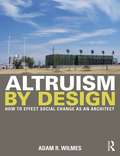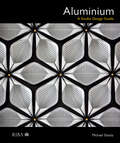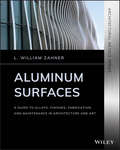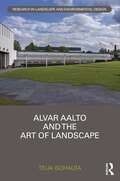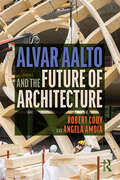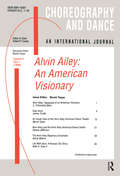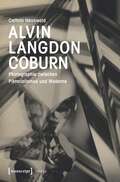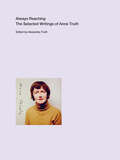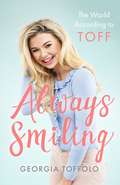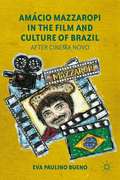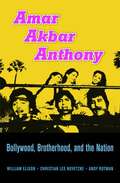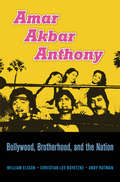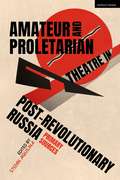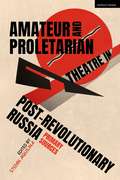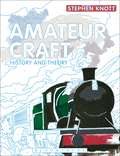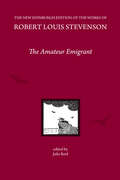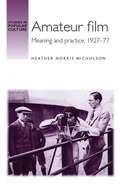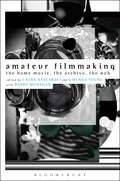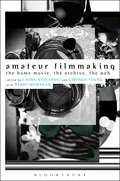- Table View
- List View
Altruism by Design: How To Effect Social Change as an Architect
by Adam R. WilmesAltruism by Design: How to Effect Social Change as an Architect is meant to prepare the individual designer – whether a student or practicing professional – for a career dedicated to serving communities in need through design and construction. It will help you understand the complexities, opportunities, and benefits of creating architecture that promotes social equality and community so that you can make a difference. What you'll learn: -How community-based studios can respond to natural disasters and economic conditions-How to build what you design-How to develop relationships with non-traditional clients-How to structure your career to be dedicated to social change and sustainable design-How to discover funding opportunities for projects in a not-for-profit firm-How to consider moral and financial aspects of your practice-How you can collaborate with other design professions to determine the future of the built environment Featuring detailed case studies, including work by Studio 804 and Pyotak Architects, and more than 100 color images; this book is essential reading for providing you with a viable path to altruistic design.
Aluminium: A Studio Design Guide
by Michael StaceyAre you making the most of aluminium? Aluminium is one of the most flexible and durable materials to design with. With exceptional strength, durability and affordability, it provides us with more than simply the ability to select products. When understood properly, aluminium becomes something to design with. In a world where over half humankind now lives in cities there is a need to design zero carbon, attractive and durable architecture. This can only be achieved if we are more resourceful, if we achieve more with less by understanding materials well, using finite element analysis and computer aided design. Aluminium can be part of that route to affordable and durable architecture. Recycling aluminium takes only 5% of the energy required to produce primary aluminium and it can be recycled almost infinitely without any loss of properties. Combining an inspirational overview of the use of aluminium in architecture and infrastructure with a technical level of detail, this book shows how useful and versatile aluminium is – and how architects can actually design with it. This book provides access to state of the art research into the best practice in application of aluminium to architecture: from curtain walling and cladding roofing to structural considerations. It demonstrates the material’s design flexibility and how it works well with other materials. Each process will be accompanied by exemplar case studies that demonstrate the potential and application. Woven into the structure of the book are the primary benefits of aluminium: its flexiblilty, its durability, its sustainable properties and its cost-effectiveness. Whether you’re a first year student or a seasoned designer or engineer, this book provides an accessible and deep dive into the uses and benefits of aluminium.
Aluminium: A Studio Design Guide
by Michael StaceyAre you making the most of aluminium? Aluminium is one of the most flexible and durable materials to design with. With exceptional strength, durability and affordability, it provides us with more than simply the ability to select products. When understood properly, aluminium becomes something to design with. In a world where over half humankind now lives in cities there is a need to design zero carbon, attractive and durable architecture. This can only be achieved if we are more resourceful, if we achieve more with less by understanding materials well, using finite element analysis and computer aided design. Aluminium can be part of that route to affordable and durable architecture. Recycling aluminium takes only 5% of the energy required to produce primary aluminium and it can be recycled almost infinitely without any loss of properties. Combining an inspirational overview of the use of aluminium in architecture and infrastructure with a technical level of detail, this book shows how useful and versatile aluminium is – and how architects can actually design with it. This book provides access to state of the art research into the best practice in application of aluminium to architecture: from curtain walling and cladding roofing to structural considerations. It demonstrates the material’s design flexibility and how it works well with other materials. Each process will be accompanied by exemplar case studies that demonstrate the potential and application. Woven into the structure of the book are the primary benefits of aluminium: its flexiblilty, its durability, its sustainable properties and its cost-effectiveness. Whether you’re a first year student or a seasoned designer or engineer, this book provides an accessible and deep dive into the uses and benefits of aluminium.
Aluminum Surfaces: A Guide to Alloys, Finishes, Fabrication and Maintenance in Architecture and Art (Architectural Metals Series)
by L. William ZahnerA full-color guide for architects and design professionals to the selection and application of aluminum Aluminum Surfaces, second in William Zahner's Architectural Metals Series, provides a comprehensive and authoritative treatment of aluminum applications in architecture and art. It offers architecture and design professionals the information they need to ensure proper maintenance and fabrication techniques through detailed information and full color images. It covers everything from the history of the metal and choosing the right alloy, to detailed information on a variety of surface and chemical finishes and corrosion resistance. The book also features case studies offering architecture and design professionals strategies for designing and executing successful projects using aluminum. Aluminum Surfaces is filled with illustrative case studies that offer strategies for designing and executing successful projects using aluminum. All the books in Zahner’s Architectural Metals Series offer in-depth coverage of today’s most commonly used metals in architecture and art. This important book: Contains a comprehensive guide to the use and maintenance of aluminum surfaces in architecture and art Features full-color images of a variety of aluminum finishes, colors, textures, and forms Includes case studies with performance data that feature strategies on how to design and execute successful projects using aluminum Offers methods to address corrosion, before and after it occurs Discusses the environmental impact of aluminum from the creation process through application Explains the significance of the different alloys and the forms available to the designer Discusses expectations when using aluminum in various exposures For architecture professionals, metal fabricators, developers, architecture students and instructors, designers, and artists working with metals, Aluminum Surfaces offers a logical framework for the selection and application of aluminum in all aspects of architecture.
Aluminum Surfaces: A Guide to Alloys, Finishes, Fabrication and Maintenance in Architecture and Art (Architectural Metals Series)
by L. William ZahnerA full-color guide for architects and design professionals to the selection and application of aluminum Aluminum Surfaces, second in William Zahner's Architectural Metals Series, provides a comprehensive and authoritative treatment of aluminum applications in architecture and art. It offers architecture and design professionals the information they need to ensure proper maintenance and fabrication techniques through detailed information and full color images. It covers everything from the history of the metal and choosing the right alloy, to detailed information on a variety of surface and chemical finishes and corrosion resistance. The book also features case studies offering architecture and design professionals strategies for designing and executing successful projects using aluminum. Aluminum Surfaces is filled with illustrative case studies that offer strategies for designing and executing successful projects using aluminum. All the books in Zahner’s Architectural Metals Series offer in-depth coverage of today’s most commonly used metals in architecture and art. This important book: Contains a comprehensive guide to the use and maintenance of aluminum surfaces in architecture and art Features full-color images of a variety of aluminum finishes, colors, textures, and forms Includes case studies with performance data that feature strategies on how to design and execute successful projects using aluminum Offers methods to address corrosion, before and after it occurs Discusses the environmental impact of aluminum from the creation process through application Explains the significance of the different alloys and the forms available to the designer Discusses expectations when using aluminum in various exposures For architecture professionals, metal fabricators, developers, architecture students and instructors, designers, and artists working with metals, Aluminum Surfaces offers a logical framework for the selection and application of aluminum in all aspects of architecture.
Alvar Aalto and The Art of Landscape (Routledge Research in Landscape and Environmental Design)
by Teija IsohautaAlvar Aalto and The Art of Landscape captures the essence of the Finnish architect’s landscape concept, emphasising culture and tradition, which characterised his approach to and understanding of architecture as part of the wider environment. From the forests of his youth to sights from his travels, Alvar Aalto (1898–1976) was influenced by outdoor landscapes. Throughout his career, he felt the need to shape the terrain and this became a signature of his architecture. Divided into five chapters, this book traces Aalto’s relationship with landscape, starting with an analysis of his definitions and descriptions of landscape language, which ranged from natural references and biological terms, to synonyms and comparisons. It includes beautifully illustrated case study projects from the 1950s and 1960s, discussing Aalto’s transformation of different landscapes through topography, terracing and tiers, ruins and natural elements, horizon outlines, landmarks, and the repetition of form. Featuring archival sketches, garden drawings, and plans, the book also contains Aalto’s text ‘Architecture in the Landscape of Central Finland’ from 1925 in the appendix. This book provides fascinating, untold insights into Aalto’s relationship with landscape and how this developed during his lifetime, for scholars, researchers, and students interested in architecture and landscape history, landscape art, and cultural studies.
Alvar Aalto and The Art of Landscape (Routledge Research in Landscape and Environmental Design)
by Teija IsohautaAlvar Aalto and The Art of Landscape captures the essence of the Finnish architect’s landscape concept, emphasising culture and tradition, which characterised his approach to and understanding of architecture as part of the wider environment. From the forests of his youth to sights from his travels, Alvar Aalto (1898–1976) was influenced by outdoor landscapes. Throughout his career, he felt the need to shape the terrain and this became a signature of his architecture. Divided into five chapters, this book traces Aalto’s relationship with landscape, starting with an analysis of his definitions and descriptions of landscape language, which ranged from natural references and biological terms, to synonyms and comparisons. It includes beautifully illustrated case study projects from the 1950s and 1960s, discussing Aalto’s transformation of different landscapes through topography, terracing and tiers, ruins and natural elements, horizon outlines, landmarks, and the repetition of form. Featuring archival sketches, garden drawings, and plans, the book also contains Aalto’s text ‘Architecture in the Landscape of Central Finland’ from 1925 in the appendix. This book provides fascinating, untold insights into Aalto’s relationship with landscape and how this developed during his lifetime, for scholars, researchers, and students interested in architecture and landscape history, landscape art, and cultural studies.
Alvar Aalto and the Future of Architecture
by Robert Cody Angela AmoiaIn the contemporary practice of architecture, digital design and fabrication are emergent technologies in transforming how architects present a design and form a material strategy that is responsible, equitable, sustainable, resilient, and forward-looking. This book exposes dialogue between history, theory, design, construction, technology, and sensory experience by means of digital simulations that enhance the assessment and values of our material choices. It offers a critical look to the past to inspire the future. This new edition looks to Alvar Aalto as the primary protagonist for channeling discussions related to these topics. Architects like ALA, Shigeru Ban, 3XN, Peter Zumthor, and others also play the role of contemporary guides in this review. The work of Aalto and selected contemporary architects, along with computer modeling software, showcase the importance of comprehensive design. Organized by the five Ts of contemporary architectural discourse—Typology, Topology, Tectonics, Technic, Thermodynamics—each chapter is used to connect history through Aalto and develop conversations concerning historical and contemporary models, digital simulations, ecological and passive/active material concerns, construction and fabrications, and healthy sensorial environments. Written for students and academics, this book bridges knowledge from academia into practice and vice versa to help architects become better stewards of the environment, make healthier and more accountable buildings, and find ways to introduce policy to make technology a critical component in thinking about and making architecture.
Alvar Aalto and the Future of Architecture
by Robert Cody Angela AmoiaIn the contemporary practice of architecture, digital design and fabrication are emergent technologies in transforming how architects present a design and form a material strategy that is responsible, equitable, sustainable, resilient, and forward-looking. This book exposes dialogue between history, theory, design, construction, technology, and sensory experience by means of digital simulations that enhance the assessment and values of our material choices. It offers a critical look to the past to inspire the future. This new edition looks to Alvar Aalto as the primary protagonist for channeling discussions related to these topics. Architects like ALA, Shigeru Ban, 3XN, Peter Zumthor, and others also play the role of contemporary guides in this review. The work of Aalto and selected contemporary architects, along with computer modeling software, showcase the importance of comprehensive design. Organized by the five Ts of contemporary architectural discourse—Typology, Topology, Tectonics, Technic, Thermodynamics—each chapter is used to connect history through Aalto and develop conversations concerning historical and contemporary models, digital simulations, ecological and passive/active material concerns, construction and fabrications, and healthy sensorial environments. Written for students and academics, this book bridges knowledge from academia into practice and vice versa to help architects become better stewards of the environment, make healthier and more accountable buildings, and find ways to introduce policy to make technology a critical component in thinking about and making architecture.
Alvin Ailey: An American Visionary (Choreography and Dance Studies Series)
by Muriel TopazDuring its three and half decades, the Alvin Ailey Company has left lasting markers on the playing field of American Modern Dance. It has established a reputation for precise but spectacular dancing, for depicting an African American ethos with sensitivity and elegance, and set standards for performance excellence. Ailey's choreography caused shock waves in the dance world of 1958 and continues to move audiences deeply. The company has also provided a paradigm for a modern dance repertory company. Contributors include Jennifer Dunning, Ronni Favors, Allan Gray, Denise Jefferson, Cynthia Sithembile West, Muriel Topaz, James Truitte, and Sylvia Waters. Eulogies written by David Dinkins, Carmen de Lavallade, Judith Jamison and Maya Angelou.
Alvin Ailey: An American Visionary (Choreography and Dance Studies Series #4.1)
by Muriel TopazDuring its three and half decades, the Alvin Ailey Company has left lasting markers on the playing field of American Modern Dance. It has established a reputation for precise but spectacular dancing, for depicting an African American ethos with sensitivity and elegance, and set standards for performance excellence. Ailey's choreography caused shock waves in the dance world of 1958 and continues to move audiences deeply. The company has also provided a paradigm for a modern dance repertory company. Contributors include Jennifer Dunning, Ronni Favors, Allan Gray, Denise Jefferson, Cynthia Sithembile West, Muriel Topaz, James Truitte, and Sylvia Waters. Eulogies written by David Dinkins, Carmen de Lavallade, Judith Jamison and Maya Angelou.
Alvin Langdon Coburn: Photographie zwischen Piktorialismus und Moderne (Image #128)
by Cathrin HauswaldAlvin Langdon Coburn ist der erste Künstler, der 1916 von »abstrakter Photographie« schreibt und sie auch ästhetisch umsetzt. Und das, obwohl er selbst der piktorialistischen Strömung, der stimmungsvollen Kunstphotographie, angehört. Anhand von Coburns Wirken als zentrale Figur des epistemisch-ästhetischen Umbruchs in der Zeit der Jahrhundertwende verdeutlicht Cathrin Hauswald eindrucksvoll die Entwicklung der Photographie vom 19. Jahrhundert in die Moderne. Sie zeigt: Während Coburn die Beben des technologischen und photographischen Fortschritts aufzeichnet und gleichsam gestaltet, inszeniert sich der Kunstphotograph selbst als ambivalentes und geradezu antimodernes Element seines photographischen Schaffens, dessen Ziel stets die eigene Nobilitierung bleibt.
Always Reaching: The Selected Writings of Anne Truitt
by Anne TruittAn expansive collection of texts providing insight into the inner life, creativity, and practice of the innovative American artist Anne Truitt Spanning more than fifty years, this comprehensive volume collects the letters, journal entries, interviews, lectures, reviews, and remembrances of the groundbreaking twentieth-century artist Anne Truitt (1921–2004). Alexandra Truitt, the artist’s daughter and a leading expert on her work, has carefully selected these writings, most of which are previously unpublished, from the artist’s papers at Bryn Mawr College as well as private holdings. Revelations about the artist’s life abound. Among Truitt’s earliest writings are excerpts from journals written more than a decade before her first artistic breakthrough, in which she establishes themes that would occupy her for decades. In later texts she shares uncommon insights into the practices of other artists and writers, both predecessors and peers. Like Truitt’s published journals, these writings offer a compelling narrative of her development as an artist and efforts to find her voice as a writer. They show that Truitt’s creative impulse to translate the inner workings of her mind into a symbolic language, so important to understanding her sculpture, predates her art.
Always Smiling: The World According to Toff
by Georgia ToffoloFor fans of Made in Chelsea, I'm a Celeb and Celebs Go Dating, ALWAYS SMILING is the first book from the nation's favourite reality TV star Toff!Everyone loves Toff and she has come a long way since bursting onto our screens on E4's Made in Chelsea in 2014. As the runaway winner of I'm a Celebrity Get Me Out of Here 2017, Toff surprised us all, not least herself, with her positive, happy-go-lucky attitude and kindness to others, no matter what challenge came her way in the jungle. In ALWAYS SMILING, Toff is here to share her experiences, some funny, some sad, some that make her cringe with embarrassment. So whether it is friendships, family dramas, heartbreak and relationships, or how she coped with living her life in front of millions of viewers of Made in Chelsea, Toff reveals how she has learnt to keep a smile on her face, whatever life throws at her. Told with her trademark honesty, humour and endless sense of fun, ALWAYS SMILING is a must-have for any fan.
Amácio Mazzaropi in the Film and Culture of Brazil: After Cinema Novo
by E. BuenoAmácio Mazzaropi's work is a unique instance in Brazilian culture - as an artist not connected with the subsidized film industry, he developed a singular voice and represents a segment of the population usually either ignored or viewed with contempt by the established, experimental filmmakers.
Amar Akbar Anthony: Bollywood, Brotherhood, and the Nation
by William ElisonThe 1977 blockbuster Amar Akbar Anthony about the heroics of three Bombay brothers separated in childhood became a classic of Hindi cinema and a touchstone of Indian popular culture. Beyond its comedy and camp is a potent vision of social harmony, but one that invites critique, as the authors show.
Amar Akbar Anthony: Bollywood, Brotherhood, and the Nation
by William ElisonThe 1977 blockbuster Amar Akbar Anthony about the heroics of three Bombay brothers separated in childhood became a classic of Hindi cinema and a touchstone of Indian popular culture. Beyond its comedy and camp is a potent vision of social harmony, but one that invites critique, as the authors show.
Amateur and Proletarian Theatre in Post-Revolutionary Russia: Primary Sources
by Stefan AquilinaThis is the first collection of primary sources that addresses the amateur theatre produced by the workers in the first decade after the Russian Revolution. Newly translated from the Russian, the essays capture both theoretical articulations on the scene – by luminaries such as Alexander Bogdanov, Platon Kerzhentsev, Valerian Pletnev, Alexander Mgebrov and Valentin Smyshliaev – and the more fleeting descriptions and first-hand accounts of the productions staged, accounts and voices which are typically harder to capture. The essays tell a story of unabashed optimism in the creativity of the working classes. They speak of the use of theatre to carve a public and political role in the construction of a new world. The sources, however, also exhibit the flipside of the scene, or the sombre difficulties faced by the amateur actors and the incessant calls to raise standards through professional help. The narrative developed is that of an amateur theatre which began as an autonomous and heterogeneous activity but which by the mid-to-late 1920s was transformed into a regulated practice and a space for cultural programming. The collection makes an important contribution to our understanding of modern theatre: scholarship conventionally tackles the canonical names from the professional world but gives little attention to the more down-to-earth forms of performance taking place in factories, clubs and amateur circles. An introductory essay also highlights the range and significance of the collection and draws links between the essays.
Amateur and Proletarian Theatre in Post-Revolutionary Russia: Primary Sources
This is the first collection of primary sources that addresses the amateur theatre produced by the workers in the first decade after the Russian Revolution. Newly translated from the Russian, the essays capture both theoretical articulations on the scene – by luminaries such as Alexander Bogdanov, Platon Kerzhentsev, Valerian Pletnev, Alexander Mgebrov and Valentin Smyshliaev – and the more fleeting descriptions and first-hand accounts of the productions staged, accounts and voices which are typically harder to capture. The essays tell a story of unabashed optimism in the creativity of the working classes. They speak of the use of theatre to carve a public and political role in the construction of a new world. The sources, however, also exhibit the flipside of the scene, or the sombre difficulties faced by the amateur actors and the incessant calls to raise standards through professional help. The narrative developed is that of an amateur theatre which began as an autonomous and heterogeneous activity but which by the mid-to-late 1920s was transformed into a regulated practice and a space for cultural programming. The collection makes an important contribution to our understanding of modern theatre: scholarship conventionally tackles the canonical names from the professional world but gives little attention to the more down-to-earth forms of performance taking place in factories, clubs and amateur circles. An introductory essay also highlights the range and significance of the collection and draws links between the essays.
Amateur Craft: History and Theory
by Stephen KnottAmateur Craft provides an illuminating and historically-grounded account of amateur craft in the modern era, from 19th century Sunday painters and amateur carpenters to present day railway modellers and yarnbombers. Stephen Knott's fascinating study explores the curious and unexpected attributes of things made outside standardised models of mass production, arguing that amateur craft practice is 'differential' – a temporary moment of control over work that both departs from and informs our productive engagement with the world.Knott's discussion of the theoretical aspects of amateur craft practice is substantiated by historical case studies that cluster around the period 1850–1950. Looking back to the emergence of the modern amateur, he makes reference to contemporary art and design practice that harnesses or exploits amateur conditions of making. From Andy Warhol to Simon Starling, such artistic interest elucidates the mercurial qualities of amateur craft.Invaluable for students and researchers in art and design, contemporary craft, material culture and social history, Amateur Craft counters both the marginalisation and the glorification of amateur craft practice. It is richly illustrated with 41 images, 14 in colour, including 19th century ephemera and works of contemporary art.
Amateur Craft: History and Theory
by Stephen KnottAmateur Craft provides an illuminating and historically-grounded account of amateur craft in the modern era, from 19th century Sunday painters and amateur carpenters to present day railway modellers and yarnbombers. Stephen Knott's fascinating study explores the curious and unexpected attributes of things made outside standardised models of mass production, arguing that amateur craft practice is 'differential' – a temporary moment of control over work that both departs from and informs our productive engagement with the world.Knott's discussion of the theoretical aspects of amateur craft practice is substantiated by historical case studies that cluster around the period 1850–1950. Looking back to the emergence of the modern amateur, he makes reference to contemporary art and design practice that harnesses or exploits amateur conditions of making. From Andy Warhol to Simon Starling, such artistic interest elucidates the mercurial qualities of amateur craft.Invaluable for students and researchers in art and design, contemporary craft, material culture and social history, Amateur Craft counters both the marginalisation and the glorification of amateur craft practice. It is richly illustrated with 41 images, 14 in colour, including 19th century ephemera and works of contemporary art.
The Amateur Emigrant, by Robert Louis Stevenson (The\new Edinburgh Edition Of The Collected Works Of Robert Lewis Stevenson Ser.)
by R. L. StevensonThe Amateur Emigrant, an autobiographical account of Stevenson’s voyage from Scotland to California in 1879, is a rich and provocative work of late-Victorian travel writing and cultural criticism. It describes vividly how Stevenson mixed with ‘steerage’ passengers aboard an Atlantic steamship and experienced the indignities of a transcontinental emigrant train. The Amateur Emigrant engages critically with Victorian ideas about class, race, and gender, and makes an important contribution to the literature of emigration. Stevenson’s middle-class family and friends found the work so transgressive that it was withdrawn from publication at proof stage. It was published in bowdlerized form in 1895 and since then has rarely been available in the form in which Stevenson composed it.
Amateur film: Meaning and practice c. 1927–77 (Studies in Popular Culture)
by Heather NicholsonAmateur film: Meaning and practice 1927–77 plunges readers into the world of home movies making and reveals that behind popular perceptions of clichéd family scenes shakily shot at home or by the sea, there is much more to discover. Exploring who, how, where, when and why amateur enthusiasts made and shared their films provides fascinating insights into an often misunderstood aspect of national visual history. This study of how non-professional filmmakers responded to the new possibilities of moving image places decades of cine use into a history of changing visual technologies that span from Edwardian visual toys to mobile phones. Using northern cine club records, interviews and amateur films, the author reveals how film-making practices ranged from family footage to highly crafted edited productions about local life and distant places made by enthusiasts who sought to ‘educate, inspire and entertain’ armchair audiences during the early decades of British television.
Amateur Filmmaking: The Home Movie, the Archive, the Web
by Laura Rascaroli Gwenda Young Barry MonahanWith the advent of digital filmmaking and critical recognition of the relevance of self expression, first-person narratives, and personal practices of memorialization, interest in the amateur moving image has never been stronger. Bringing together key scholars in the field, and revealing the rich variety of amateur filmmaking-from home movies of Imperial India and film diaries of life in contemporary China, to the work of leading auteurs such as Joseph Morder and Péter Forgács-Amateur Filmmaking highlights the importance of amateur cinema as a core object of critical interest across an array of disciplines. With contributions on the role of the archive, on YouTube, and on the impact of new technologies on amateur filmmaking, these essays offer the first comprehensive examination of this growing field.
Amateur Filmmaking: The Home Movie, the Archive, the Web
by Laura Rascaroli Gwenda Young Barry MonahanWith the advent of digital filmmaking and critical recognition of the relevance of self expression, first-person narratives, and personal practices of memorialization, interest in the amateur moving image has never been stronger. Bringing together key scholars in the field, and revealing the rich variety of amateur filmmaking-from home movies of Imperial India and film diaries of life in contemporary China, to the work of leading auteurs such as Joseph Morder and Péter Forgács-Amateur Filmmaking highlights the importance of amateur cinema as a core object of critical interest across an array of disciplines. With contributions on the role of the archive, on YouTube, and on the impact of new technologies on amateur filmmaking, these essays offer the first comprehensive examination of this growing field.
